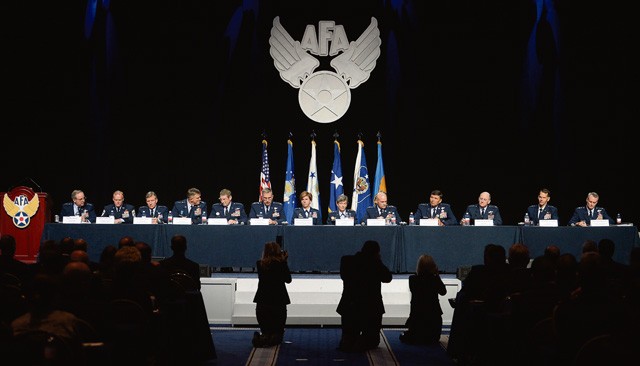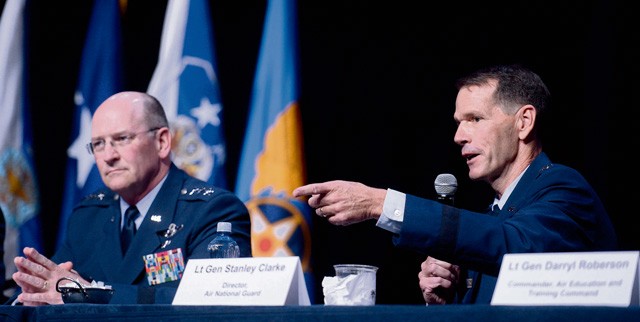
WASHINGTON — Members of the Air Force, Air Force Association and defense industry were invited to a Q-and-A session with Air Force Chief of Staff Gen. Mark A. Welsh III, Chief Master Sgt. of the Air Force James M. Cody and several major command commanders during a four-star forum at the AFA Air and Space Conference and Technology Exposition Sept. 16 in Washington, D.C.
Moderated by Welsh, audience members submitted questions directly to the panel during the discussion that covered current and future operations, taking care of Airmen, budgetary constraints, modernization and a variety of other topics. Despite the broad range, some recurring themes emerged. Airmen want to see the next generation Air Force. They want to modernize weapons systems quickly and efficiently and move new technology into the fight.
Here are the highlights.
Question 1: If fifth-generation platforms won’t be able to exercise everything they can really do out in the open, where can adversaries see it? What’s going to change about exercises like Red Flag?
“Our ability to work in the virtual live constructive environment, where AFRL (Air Force Research Laboratory) is doing some fantastic work,” said Gen. Herbert J. “Hawk” Carlisle, the commander of the Air Combat Command. “There’s an incremental move called SLATE, where we’re able to fly in an open air environment. This is in the future and we’re going to need industry’s help to get us there.”
Question 2: How are we going to maintain agility in space, with assets that are unadaptable and a changing threat?
“We’re going to build it for capabilities,” said Gen. John E. Hyten, the commander of the Air Force Space Command. “The challenges we have are a system, we have a system that loves the status quo, and the status quo is not built for the 21st century, it’s built for the 20th century. So we have to work inside the system to come up with a different way of thinking about space. We have to come up with a different way to think about cyber. We have to come up with a different way of thinking about all these pieces together; but we have to effectively build the capabilities that can effectively operate in that regime. We understand what those capabilities are, now we have to get the systems built.”
Question 3: The Army is switching their uniforms to a multi-cam uniform. When will the Air Force be switching our camouflage?
“I don’t think we’re going to switch our uniforms,” said Chief Master Sgt. of the Air Force James A. Cody. “The reality is, we’re pretty satisfied with our ABUs (Airman battle uniform), and to switch them would cost us quite a bit of money. We’ll continue to wear the OCP when in the environment, that’s the proper uniform.”
Question 4: How big a problem for you are these runways on reefs that China’s constructing? Does it measurably change your warning time or engagement zones?
“The concern as they put down the 10,000-foot runway is that now maybe they put down an air defense identification zone, and then be able to defend it,” said Gen. Lori Robinson, the Pacific Air Forces commander. “As we heard Dr. (Ashton) Carter talk this morning, everybody is able to operate in international airspace and sail in international waters. If they militarize those runways, it will threaten our ability to do that.”
Question 5: We welcome your thoughts on how to best support small businesses in an era of fiscal constraint.
“Small businesses are the heart and soul of this country,” said Gen. Ellen M. Pawlikowski, the commander of the Air Force Materiel Command. “That’s really what it’s all about when you look at the contributions that they have made. I’ve always been a real strong advocate of small business. I think one of the key aspects of small businesses is to be able to transition that capability into our weapons systems or into the facilities that we have. We have set a focus on small business across Air Force Materiel Command in targeting a focus particularly at the research lab. One of the things that we’re doing is going directly from Small Business Innovation Research System into SBIRS Phase II. Instead of having to do a two-step process, our small businesses will be able to bring their technology directly into Phase II and that’s a step closer to being able to transfer in.”
Question 6: The secretary said the time mark on the KC-46 Pegasus is about used up. What are the implications if the KC-46 is delayed by more than a few months?
“As a recipient of that product, I am cautiously optimistic that the product is going to roll out. What it means for capability, that airplane is going to prove itself out time and time again, but we’ve got to hold to that schedule,” said Gen. Carlton D. Everhart II, the Air Mobility Command commander. “Because if you look at the impact it has on other modernization programs, I’ve got to make sure that AMC stays combat ready. Combat readiness and development in the future is what drives this. So, we’re watching this schedule and we’re watching it closely. I think Boeing will be able to deliver, but we’ve got to hold them to the contract.”
Question 7: What is the most important new capability that you expect to need in the next decade and why?
“The first thing that we are pursuing right now is taking the cover of weather away from the enemy in the current fight in Afghanistan,” said Lt. Gen. Bradley A. Heithold, the commander of the Air Force Special Operations Command. “The enemy tends to seek objectives when the weather hampers coalition air. The number one thing we want to do is take that away from them.
“Second, I’ve got to put directed energy, high-energy lasers, onboard to defend them in orbit and also to use these things offensively to engage the targets. I believe we can make things quick work because you don’t hear it, or see it. By the time you know we’re there, it’s too late.”
Question 8: How will you build on the work that has already been done on revamping the nuclear enterprise, and can you state your top priorities in doing it?
“There have been a lot of positive efforts made across the nuclear enterprise, so I’m going to continue that drive,” said Gen. Robin Rand, the commander of the Air Force Global Strike Command.
“My priorities are number one: If nuclear command and control is a critical function for our nation and our senior decision makers, you’ve got to have a platform to deliver that, and that’s the nuclear command and control communications. The Air Force has the lead on about 75 percent of what makes up that system, so I’ll be collaborating with a lot of my fellow MAJCOM commanders here who own a lot of those different resources and systems to make sure we’re able to deliver. God forbid on our nation’s worst day our senior leaders and the president can communicate.
“Number two: We’ve got to continue to modernize and recapitalize where we can. The ICBM (intercontinental ballistic missile) and UH-1N (Iroquois), the B-2 (Spirit) and the B-1B (Lancer), and when we get the announcement for the long range strike bomber that we’re driving that to IOC (initial operational capability) in 2020 and be capable of delivering what our nation needs in 2030.
“Number three: professional development. Particularly this is a priority. We have great young men and women in Air Force Global Strike. If we have problems with our people, I challenge our leaders, it’s because we have to lead them better.”
Number 9: Do you anticipate the National Guard being deployed or employed at any time in any capacity to secure borders in the near future?
“Actually we’re on the borders right now sir. We are deployed in every part of the United States right now,” said Lt. Gen. Stanley E. Clarke III, the Air National Guard director. “The reason we’re able to sit comfortably in this room is because someone is on alert covering us, right now. If there’s a requirement for us to do a mission in the homeland, something that everyone understands in the Guard is regardless of whether they’re Air Force or Army, they are required to do that state mission as well.”
Question 10: Is there one major thing that a future cadet or young officer can begin to work on for their future?
“Get out of your comfort zone early and often,” said Lt. Gen. James Jackson, the commander of the Air Force Reserve Command. “Look for that opportunity and when you feel uncomfortable, it’s probably the best learning experience that you’re going to have.”
Question 11: F-22 Raptors were recently deployed to Europe. Bedding down F-22s there was not in the plan, but now that Russia seems to have taken a long-term aggressive posture, do you see an F-22 base in Europe or a semi-permanent detachment like the bombers in Guam?
“The move to introduce the F-22 in the European theater was made a long time ago in our effort to assure our allies and deter our enemies,” said Gen. Frank Gorenc, the U.S. Air Forces in Europe and Air Forces Africa commander. “It has done a lot to assure our partners. You can bet that I will be asking for that priority. I understand there are priorities, but I hope to be cut above the line. Not only did we move the F-22, but we also moved in MQ-1B (Predators) … which is an enormous accomplishment.”
Question 12: What does the AETC position, being lowered to a three-star job, mean to its mission and its chain of command?
“The Air Education and Training Command is essential to our Air Force,” said Lt. Gen. Darryl Roberson, the AETC commander. “Air power starts here at AETC. It’s so fundamental, everyone here at this table understands how fundamental it is. So whether you have a three-star or four-star is not critically important.”



